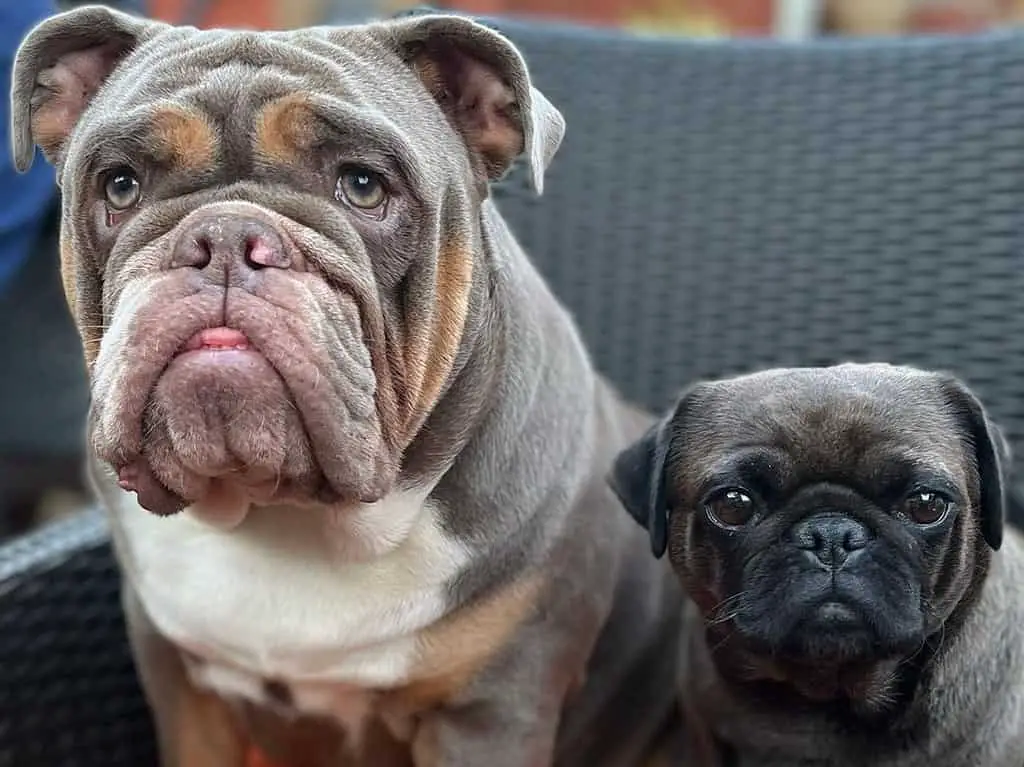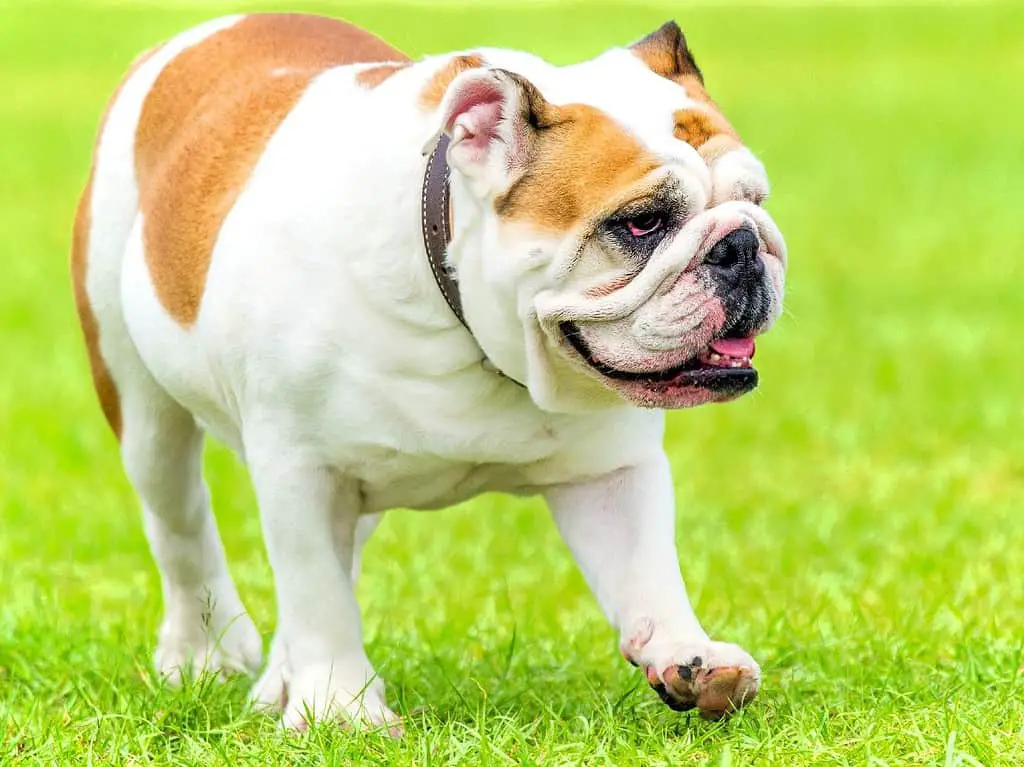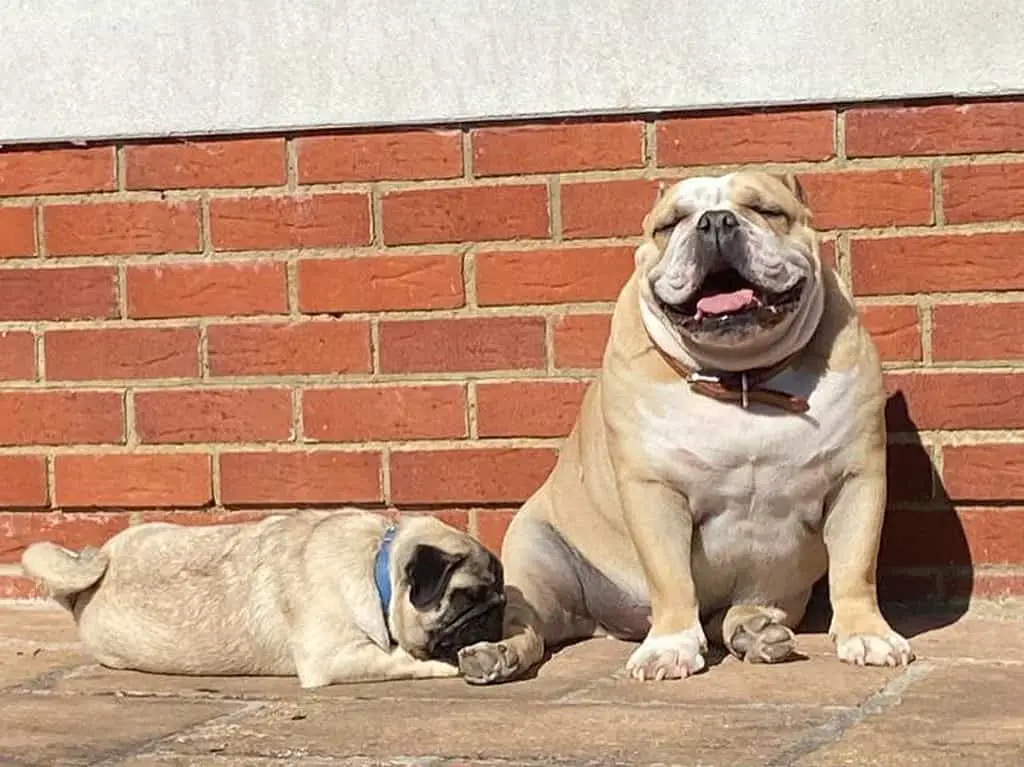Are you considering adopting a furry friend but can’t decide between an English Bulldog and a Pug? Both breeds are adorable, compact, and have distinct features. However, it would be best if you thought beyond their physical features. Their temperament, energy level, and health should be carefully considered before adoption.
That’s why we’re here to help you figure out which breed makes for the best pet – the English Bulldog vs Pug. We’ll review their exceptional qualities, distinct personalities, and expected care requirements.

History of English Bulldog and Pug
Explore their origins, rise to popularity, notable historical moments, and what makes them such wonderful pets today.
English Bulldog

The English Bulldog, commonly called the Bulldog, has a long history of being bred for its strength, tenacity, and ability to subdue a bull. These traits were particularly desirable during the Middle Ages in England when the bull-baiting sport became popular.
During the 17th century, bull-baiting saw a huge decrease in popularity, prompting an alteration in purpose. Bulldogs consequently found new roles offering companionship and protective services to humans. At this time, their iconic build became more apparent, including a compact frame, broad chest, wrinkled face, and undershot jaw. Their short stature and stocky build quickly distinguished them from different types of dogs.
During the 18th and 19th centuries, the English Bulldog gained steadily increasing recognition among people of all types. Butchers found these dogs helpful in restraining uncooperative livestock, while lace workers appreciated their friendly presence in the work environment. English Bulldogs gradually assumed a standing as symbols that characterize British national pride.
Despite facing significant difficulties during the 19th century, the English Bulldog breed was fortunately rescued from near extinction through a collective effort of animal enthusiasts. Such individuals included a combination of dog breeders and their associated clubs who identified the breed’s unique characteristics and subsequent historical importance. Consequently, in response to The Cruelty to Animals Act of 1835 which effectively barred bull-baiting and other forms of abuse towards animals, they endeavored to protect and promote it for future generations.
In the early 1900s, interest in English Bulldogs in England and abroad was resurgent. They were imported to the United States, where their distinctive features and pleasant demeanor quickly made them popular companions among individuals and families. As recognition for this breed grew, it was recognized by the American Kennel Club (AKC) in 1886.
Throughout the years, breed standards for English Bulldogs have transformed as an increasing focus has been placed on health and temperament. Significant efforts have been made to reduce health risks related to genetics, such as respiratory conditions and joint dysfunction. Responsible breeding activities are now more commonplace to guarantee a sustainable future for the breed’s welfare.
English Bulldogs have remained beloved animals for many years, partly due to their gentle and kind disposition, despite prior usage in bull-baiting. With their distinctive features and personalities, it is no surprise that this breed occupies an essential place within family settings and community life. It is fitting then that their long history of domestication has contributed to its constant admiration today.
Pug

It is believed that the Pug first came from China during the Han Dynasty period (206 BC to 220 AD) and was highly prized by noble families. They were kept in luxurious conditions and treated with immense admiration, often presented as an esteemed gifts to foreign dignitaries. This indicates their significant status within Chinese royal households at the time.
In the 16th century, Dutch traders imported Pugs from China into the Netherlands. From there on, they became the choice of many influential aristocratic households as pets, including Queen Victoria of England.
Pugs have been lauded for their friendly and loving nature since becoming a recognized breed. Bred to be devoted companions, these dogs offer perpetual amusement and camaraderie to their owners. Their physical attributes, including the unique muzzle shape and large eyes, may have had a large part in why they have remained so popular. Through time their endearing demeanor has kept them relevant.
Throughout the 19th century, Pugs decreased in popularity across Europe. However, they gained a whole new fanbase due to their recognition by the American Kennel Club in 1885 and eventually rose back to prominence as beloved companions. Reputation for the breed steadily increased state-by-state as the 20th century progressed.
The Pug has achieved global popularity owing to its amicable and spirited behavior. They demonstrate dynamic characteristics making them suitable companions for family life. Their small build and accommodating disposition make them great life partners for students, bachelors, and others living in small apartments. Still, regular grooming is recommended to ensure cleanliness and maintain facial wrinkles.
Although Pugs have long been associated with nobility and the upper class of society, they have since developed into dogs that are deeply cherished by family households worldwide. This breed continues to be popular due to its striking looks and endearing personalities. Therefore, it is unsurprising that they remain a top choice among dog lovers.
Read also: A Look At The Pug LifeSpan And How To Prolong Their Life
English Bulldog vs Pug: Appearance
When comparing the English Bulldog and the Pug in terms of appearance, both breeds are known for their distinctive and unique features. Let’s discuss each breed in detail:
English Bulldog
Learn below the key characteristics of the English Bulldog’s appearance.
Head: The English Bulldog is easily recognized by its prominent, broad, and square-shaped head. In addition to having a skull of considerable proportions, wrinkles, and folds are distinctive features present along the forehead. Additionally, the muzzle appears short and pug-like, with a significant width and depth in the jawline.
Face: The English Bulldog is recognized for its largely flat features, with an extended lower jaw extending past the upper. These distinguishing characteristics of the facial structure have given this breed its well-known, frown-like expression.
Eyes: The eyes of an English Bulldog are usually deep-colored and positioned at the base of their skull. They possess a round shape with a wide distance between each eye, creating an alert and observant appearance.
Ears: They have small, thin ears set high on the head. They are folded back, creating a “rose” or “button” shape, and sit close to the skull.
Body: Bulldogs feature an impressively robust and powerful physique. Their chests are broad, shoulders well-developed, and ribcages form a deep barrel shape. Combined with their short or ‘squat’ stature, this contributes to their uniquely low-slung build.
Coat: The English Bulldog has a coat that is short, dense, and smooth in texture. It may come in white, fawn, brindle, red, or any combination of these colors.
Pug
The Pug is a small, sturdy dog with a charming and playful personality. Here are some key features of the Pug’s appearance:
Head: The Pug breed has a disproportionate head, which is spherical and significantly larger than would typically be expected with the size of their bodies.
Face: Their short, blunt muzzle and deep wrinkle give these dogs a friendly, lovable appearance.
Eyes: Pugs have cartoon-like eyes. Big, round, and bulging out of their sockets, they give pugs a cute look.
Ears: Pugs have tiny, squishy ears you’ll want to rub all day long.
Body: Pugs are short yet muscular, boasting a large chest and round ribs. Although they are small in size, pugs display an impressively strong figure.
Coat: Pugs possess a coarse yet glossy double coat, varying in color from fawn to silver or apricot. Markings called black mask often appears on their face.
To recap, the English Bulldog and the Pug are two distinct breeds immediately recognizable by their physical characteristics. While the English Bulldog boasts a more muscular frame and squarer head, the Pug is smaller with a rounder head. Moreover, these two breeds flaunt features such as flattened faces, wrinkles, and expressive eyes.
Comparison of Personality Traits
While there may be some similarities, notable differences set them apart when comparing their temperaments.
English Bulldog
Gentle and Docile: Bulldogs are generally known for their steady temperament and good-natured character. This makes them compatible with families, particularly households with young children or other pets.
Relaxed and Laid-Back: Bulldogs have moderate energy levels and are relaxed. They are typically not wired for vigorous or strenuous activity and favor harmony in their environment. Exercise that is done in moderation is usually satisfactory for them, as they enjoy spending time lounging around the house.
Affectionate and Loving: Bulldogs develop strong relationships with their caregivers and display behaviors indicative of high levels of affection, love, and loyalty. These dogs desire frequent interaction with humans and thrive when included in family activities. Furthermore, they are particularly friendly towards children.
Stubbornness: Training a Bulldog can be difficult due to its independent and stubborn nature. Therefore, it is important to use consistent methods and positive reinforcement techniques for training to be successful.
Pug
Sociable and Playful: Pugs have established themselves as a breed for being generally well-mannered, good-natured, and welcoming of people. They often convey an amiable disposition suitable for many households, particularly those with children and other pets. This sociability extends to strangers, so their desire for companionship opens them to forming strong connections with humans.
Easygoing and Adaptability: Pug dogs typically maintain a tranquil nature, permitting them to readily conform to numerous environments—their preference for residing in rented apartments or condos allows them to easily transition into different lifestyles. Regrettably, due to their short snouts, they are prone to hypersensitivity when exposed to unfavorable temperatures.
Affectionate and Comical: Pugs are devoted to their owners, enjoying close physical contact. They may also bring cheerfulness into the home due to their playfulness and amusing behavior, which has earned them the nickname “clowns.”
Training and Stubbornness: Despite having an independent streak, Pugs can successfully train when provided with consistent and positive reinforcement. Rewarding the dog’s good behavior with praise or treats is beneficial once they have completed a task correctly. With commitment and consistency, owners can help their Pug develop self-control and obey commands promptly.
English Bulldog vs Pug: Activity Levels and Exercise Requirements
English Bulldogs and Pugs are considered brachycephalic breeds, acknowledged for their flattened skull shape and shortened snouts. Unfortunately, this physical trait commonly brings on respiratory difficulties and increases the risk of overheating during exercise. As a result of these potential matters, the amount of exercise required for each respective breed remains relatively low compared to other high-energy dog breeds.
Read also: Why Is My Baby Pug Breathing Hard?
Comparatively, the probability of weight gain amongst English Bulldogs is higher; for this reason, it is essential that their dieting restrictions are closely monitored, and they perform regular yet light workouts.
Providing both breeds with mental stimulation and interactive play is vital to ensure physical and mental well-being. Puzzle toys, obedience training, and appropriate indoor games can help sustain intellectual engagement while preventing boredom.
Ease of Training and Common Challenges
English Bulldogs and Pugs often exhibit a strong sense of autonomy. Although they are often willing to please their owners, both breeds may demonstrate stubborn tendencies which require patient and consistent training practices. Establishing an evident leadership structure coupled with positive reinforcement tactics has proven to be the most successful technique when working with these two breeds.
Pugs are energetic and eager to participate in activities, making training pleasurable. However, due to the high energy levels, it can be difficult to keep them focused on the task at hand. Consequently, owners of these dogs should supply adequate mental stimulation and exercise alongside shorter training periods.
Grooming Needs
Both breeds have short coats, reducing the need for extensive grooming or regular haircuts. Due to such low-maintenance requirements, these breeds are ideal for busy pet owners or those unwilling to devote substantial time to grooming. Furthermore, they shed moderately throughout the year. Therefore, routine brushing maintains their coat’s cleanliness and health.
Nevertheless, there are some notable differences in grooming needs between English Bulldogs and Pugs. English Bulldogs have more wrinkles than Pugs, requiring extra attention in cleaning their facial folds and body. This should be done regularly with a damp cloth or pet wipes, as this helps to remove dirt and debris from the creases that can cause skin irritations or infections. In contrast, Pugs have fewer folds in their facial region, thus making them easier to groom.
There is a marked discrepancy regarding the facial features of Pugs and English Bulldogs. It is common for Pugs to have eyes that are sensitive and routinely suffer from drying, tearing, and infections. To keep their eyes healthy, owners should be diligent in cleaning around the eye area regularly while also using specific liquid drops used for this purpose, as suggested by a veterinary professional. While English Bulldogs may be prone to specific eye-related issues, they do generally not face the same eye problems as Pugs.
Both Bulldogs and Pugs require meticulous ear care. Their droopy ears can easily trap moisture, which could bring about ear infections. To prevent the possibility of infection, careful cleaning with a veterinarian-approved cleanser. Likewise, redness or any abnormal odor should be inspected regularly.
Common Health Issues For Each Breed
English Bulldogs and Pugs possess a brachycephalic anatomy, manifesting as a flat, pushed-in face. Unfortunately, this attribute carries with it the potential to cause medical concerns particular to these breeds. Health issues often seen in these breeds encompass respiratory ones, including brachycephalic airway syndrome, which can cause breathing difficulties, snoring, and overheating. Such obstacles may be even more challenging due to their short muzzles and narrow nostrils, which make effective cooling incredibly challenging under hot conditions.
These breeds also often experience skin issues, with the English Bulldog and Pug possessing folds of skin and wrinkles. If these areas are not regularly kept hygienic via routine cleaning and drying, bacteria and yeast infections can occur in these creases – a risk that must be mitigated with adequate attention to their care.
While both breeds are predisposed to particular health concerns, as discussed above, they each exhibit disparities in their susceptibility. Bulldogs have an elevated possibility for orthopedic issues such as hip and elbow dysplasia, leading to limited mobility and pain.
Conversely, Pugs typically experience more medical issues related to their eyes. Corneal ulcers, dry eye, and proptosis are common disorders among this breed. Since their eyes stand out more prominently than other breeds, they are at an elevated risk for injury that can be dictated by environmental conditions such as dust or debris. Additionally, neurological disorders like epilepsy are also more prevalent in this breed.
To sum up, both English Bulldogs and Pugs have specific issues regarding their brachycephalic features that can lead to health complications. Owners of these breeds must familiarize themselves with the potential conditions to ensure they provide adequate care, like veterinary visits, proper nutrition, exercise suitable for the breed’s needs, and general attention.
English Bulldog vs Pug: Which breed suits your lifestyle?

A well-informed decision on whether an English Bulldog or a Pug is the best for you requires consideration of your preferences and lifestyle. English Bulldogs may be the desired option when wanting a less hyperactive dog with a larger, sturdier build, Pugs may be more suitable for those looking for a sociable pooch with an energetic disposition. Ultimately, the most suitable choice for a pet must go beyond mere external characteristics; you must interact with both breeds to gain knowledge regarding their respective needs before making your final decision.




